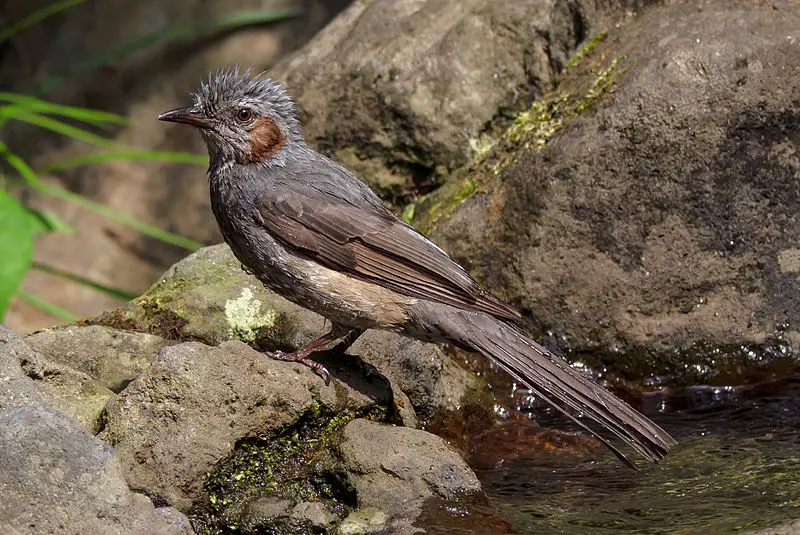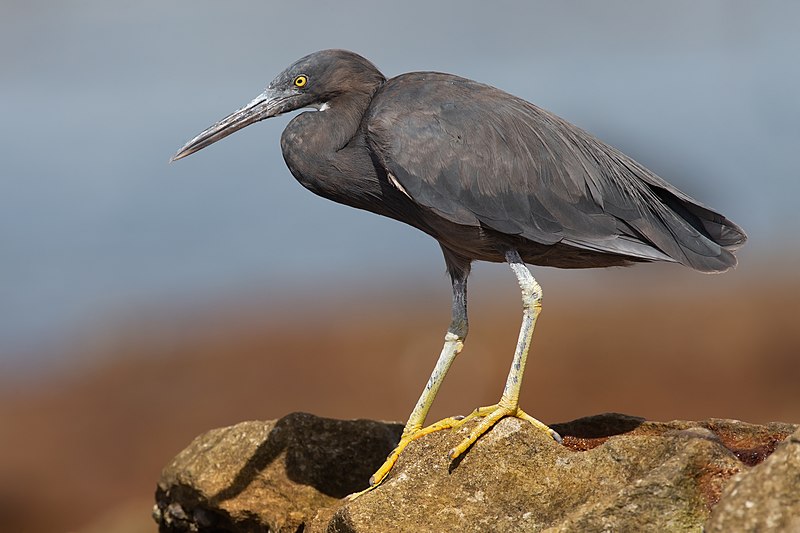Hyōgo, a prefecture in Japan, boasts an incredible diversity of birdlife. Nestled between the Sea of Japan and the Seto Inland Sea, and with varied mountain ranges and forests, this region is home to over 400 species of birds.
From migratory birds to endemic species, birds in Hyōgo offer a fascinating insight into the region’s natural richness. The prefecture’s favorable weather conditions and varied landscape attract bird lovers worldwide.
This article aims to provide an overview of Hyōgo’s birds, highlighting some of the most fascinating and noteworthy species that call this region home.
10 Birds Of Hyōgo
Hyōgo Prefecture, located in the Kansai region of Japan, boasts a diverse range of avian species due to its varied landscapes, including mountains, coastlines, and urban areas.
Here are 10 birds you might find in Hyōgo:
1. Japanese Pygmy Woodpecker
The Japanese pygmy woodpecker (Yungipicus kizuki) is a small species of woodpecker found in forests in Russia, China, Korea, and Japan. It was first described by Temminck back in the 1800s.
This bird generally lives within coniferous or deciduous trees and primarily feeds on insects like ants that it finds under bark or on dead branches.
Its plumage consists mainly of black wings with white patches along its shoulder and an orange-red crown to differentiate males from females, which lack this trait.
The International Union for Conservation of Nature has assessed this species as least concern due to their wide range across several countries.
They are quite common, though rarely seen outside heavily forested areas due to their size and natural shyness around people.
Scientific classification:
| Kingdom | Animalia |
| Phylum | Chordata |
| Class | Aves |
| Order | Piciformes |
| Family | Picidae |
| Genus | Yungipicus |
| Species | Y. kizuki |
Also Featured In: Common Birds in Japan, Tokyo Birds You Need to Know
2. Brown-Eared Bulbul

The Brown-eared Bulbul is a medium-sized bird native to eastern Asia. Its range stretches from southern Sakhalin to the northern Philippines and can be found in abundance throughout its habitat.
The species was initially classified as part of the Turdus genus before being reclassified into other genera – most recently Microscelis.
These birds are characterized by their unique brown ear tufts, which have earned them their common name.
They typically measure around 20 cm long with greyish olive-colored feathers covering much of their body except for white underparts and wings marked with black bars on each feather.
Their diet consists mainly of insects, but they also feed on fruits such as berries when available and some small invertebrates like beetles or caterpillars.
With an impressive vocal range that includes calls and songs, these birds make great additions to any garden or aviary.
Scientific classification:
| Kingdom | Animalia |
| Phylum | Chordata |
| Class | Aves |
| Order | Passeriformes |
| Family | Pycnonotidae |
| Genus | Hypsipetes |
| Species | H. amaurotis |
Also Featured In: Common Birds of Sapporo, Most Common Fukuoka Birds
3. Warbling White-Eye
The Warbling White-Eye is a small passerine bird of the white-eye family, found in East Asia from Russia to Japan, Indonesia, Korea, and the Philippines.
Its distinct yellow forehead and olive back stand out amongst other birds. Its beady black eyes are surrounded by bright white rings, giving it an alert appearance.
A distinctive warble can be heard during breeding season when they form large flocks for food or shelter.
During winter, these flocks disperse into smaller groups, making them elusive but never far away.
This beautiful little bird is an important part of many local ecosystems, so we should appreciate their beauty while protecting them from potential threats like habitat destruction and climate change.
Scientific classification:
| Kingdom | Animalia |
| Phylum | Chordata |
| Class | Aves |
| Order | Passeriformes |
| Family | Zosteropidae |
| Genus | Zosterops |
| Species | Z. japonicus |
Also Featured In: Most Common Taiwan Birds, White Oahu Birds
4. Pacific Reef Heron

The Pacific reef heron is a species of heron found throughout Southern Asia and Oceania. It has two distinct color morphs, one with slaty grey plumage and the other fully white.
This bird is easily identifiable by its long legs and yellow bill, used to forage in shallow water bodies.
The sexes look alike except for minor differences such as size or body shape.
They feed on small fish, amphibians, crustaceans, and mollusks that they find near reefs or mangroves where they roost during daytime hours, often preening their feathers if disturbed by predators like hawks or eagles.
When breeding season arrives, these birds become more vocal, using loud honking calls to attract mates before settling down into nests built among trees around wetlands or coastal areas.
Scientific classification:
| Kingdom | Animalia |
| Phylum | Chordata |
| Class | Aves |
| Order | Pelecaniformes |
| Family | Ardeidae |
| Genus | Egretta |
| Species | E. sacra |
Also Featured In: Birds of the Philippines, Common Republic of Nauru Birds
5. Common Greenshank
The Common Greenshank is a type of water belonging to the large family Scolopacidae. Its name originates from Aldrovandus in 1599 and references Aristotle’s ancient Greek work, which mentions a thrush-sized bird with a white rump and tail bobbing.
Its scientific name, “nebularia,” actually means mist. This small bird can be found near wetlands or marshes throughout Europe and Asia – it has even been spotted as far south as Africa.
They are known for their long legs, allowing them to easily traverse shallow water while searching for food like insects, crustaceans, mollusks, or worms.
The Common Greenshank is an interesting species whose beauty should not go unnoticed by any nature enthusiast.
Scientific classification:
| Kingdom | Animalia |
| Phylum | Chordata |
| Class | Aves |
| Order | Charadriiformes |
| Family | Scolopacidae |
| Genus | Tringa |
| Species | T. nebularia |
Also Featured In: Egyptian Birds, Common Estonian Birds
6. Oriental Stork
The Oriental stork is a majestic bird belonging to the family Ciconiidae. It has white plumage and black wing feathers, making it easily distinguishable from other species of birds.
They are bigger than their European White Stork cousins, with an average size of 100-129 cm. Found in Japan and Korea primarily, the first sighting was reported by Robert Swinhoe in 1873.
They inhabit wetland ecosystems such as riverbanks or marshes, where they feed on fish, amphibians, and reptiles, which makes them effective pest controllers for farmers.
Despite being listed as endangered due to habitat loss & illegal hunting practices, conservation efforts have helped populations increase significantly over recent years – allowing us all to enjoy these beautiful creatures.
Scientific classification:
| Kingdom | Animalia |
| Phylum | Chordata |
| Class | Aves |
| Order | Ciconiiformes |
| Family | Ciconiidae |
| Genus | Ciconia |
| Species | C. boyciana |
Also Featured In: Native South Korean Birds,
7. Grey-Tailed Tattler
The Grey-tailed Tattler is a small shorebird belonging to the genus Tringa. It has an unmistakable noisy call, which gives it its name.
These birds are found in coastal areas of Siberia and Polynesia, as well as some other places around Asia and Australia.
They have mottled grey plumage with darker wings, white bellies, and long yellow legs; they also have distinctive black stripes on their necks that run down onto their chests.
The Grey-tailed Tattler feeds mainly on aquatic insects or worms at low tide but will sometimes take seeds from plants when available.
During breeding season, these birds nest near water bodies such as rivers or creeks in shallow depressions lined with leaves made by both parents, who then share incubation duties for about three weeks until the eggs hatch, after which time both males and females help raise young chicks before they fledge within about 30 days of hatching.
Scientific classification:
| Kingdom | Animalia |
| Phylum | Chordata |
| Class | Aves |
| Order | Charadriiformes |
| Family | Scolopacidae |
| Genus | Tringa |
| Species | T. brevipes |
Also Featured In: Cook Islands birds, Birds You’ll Find in Hokkaido
8. Black-Tailed Gull
The black-tailed gull is a medium-sized bird native to the shorelines of East Asia. It has yellow legs and a red and black spot at the end of its bill, distinguishing it from other species in the area.
Males are larger than females, but both have identical features; otherwise, males measure 46 cm tall with wingspans between 126 – 128 cm wide, while females typically measure smaller than this.
This type of gull takes four years to reach full maturity when they become white-headed adults for breeding season, which occurs annually in May or June.
They usually lay two eggs during that time and can be seen flying around coasts all over East Asia, even outside their mating period.
Scientific classification:
| Kingdom | Animalia |
| Phylum | Chordata |
| Class | Aves |
| Order | Charadriiformes |
| Family | Laridae |
| Genus | Larus |
| Species | L. crassirostris |
Also Featured In: Gulls Species,
9. Grey-Faced Buzzard
The Grey-faced Buzzard is a small raptor found in Manchuria, Korea, and Japan. It is known for its grey head, neck, breast, and white throat.
The adult buzzard also has distinctive black mustaches and mesial stripes, adding to its unique appearance.
This bird of prey feeds on lizards, small mammals, and large insects and can often be seen in open land areas.
The Grey-faced Buzzard can be found in Southeast Asia during the winter months. Despite its small size, this bird is a formidable predator and an important part of the ecosystem in its native range.
Scientific classification:
| Kingdom | Animalia |
| Phylum | Chordata |
| Class | Aves |
| Order | Accipitriformes |
| Family | Accipitridae |
| Genus | Butastur |
| Species | B. indicus |
Also Featured In: Most Common Birds Live in Osaka, Birds of Kobe
10. Pale Thrush
The pale thrush is a passerine bird found in the eastern Palearctic region. It is closely related to the eye-browed thrush and grey-backed thrush.
Measuring 23 cm long, it has pale pinkish-brown feet and a grey bill above, which is yellow below.
The male has a brown upper body with a blue-grey head and throat, while the underparts are pale brown.
This bird’s plumage helps it blend in with its environment, making it hard to spot. It feeds on insects, worms, and berries, often searching for food on the ground.
These birds have a melodious song and are known for their pleasant calls. The pale thrush is a migratory bird, and its breeding season lasts from May to July.
Despite being a common species, habitat destruction and hunting threaten its population, and conservation measures are necessary to ensure its survival.
Scientific classification:
| Kingdom | Animalia |
| Phylum | Chordata |
| Class | Aves |
| Order | Passeriformes |
| Family | Turdidae |
| Genus | Turdus |
| Species | T. pallidus |
Also Featured In: Yakushima Island Birds You Should Know,
Conclusion
Hyōgo Prefecture is home to diverse avian species, ranging from small passerines like the Japanese White-eye and Japanese Wagtail to larger birds of prey like the Japanese Sparrowhawk.
With its varied landscapes and habitats, including mountains, coastlines, and urban areas, Hyōgo offers birdwatchers and nature enthusiasts ample opportunities to observe and appreciate the rich birdlife that inhabits this region of Japan.
Whether in the bustling urban centers or the tranquil natural reserves, birdwatching in Hyōgo will be a rewarding experience for any enthusiast.